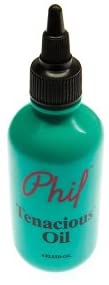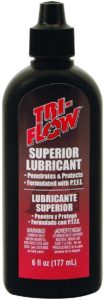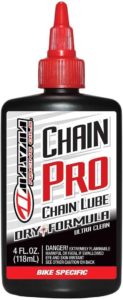The chain is one of the most important parts of your bicycle, and one of the hardest-working. Naturally, this is one of the parts of a bike that requires regular maintenance. It is the chain, after all, that rotates and moves the gear sprockets and metal cranks. All of these movements create friction, and this friction will, overtime, wear out both your chain and drivetrain. It goes without saying that once they’re sufficiently worn out, your bike will be rendered virtually useless. The best indicator that your chain is in need of maintenance is the sound the drivetrain makes as it operates. Does your drivetrain sound rattly, and are your gears not shifting as smoothly as they used to? Well, this means it’s time to oil them up, if not replace a part or the whole thing entirely.
Of course, the easiest and most effective way to lengthen the life of your chain, metal cranks, sprockets—and, really, all the mechanical parts of your bike—is to reduce the friction that is necessarily generated when they are in use. This means keeping them regularly oiled or lubed so that each part can glide more smoothly and efficiently against each other. Not all kinds of oil and lubrication products are suited for a bike’s mechanical parts, however, and the wrong product can end up doing more damage than good. Also, even the riding conditions that you find yourself frequently in will help determine the oil or lubricant that’s most suited for your bike.
In this article, we’ll discuss bicycle chain oils, how to use them, and give you a roundup of oils that we think are best for which types of bike, and which types of riding conditions. Hopefully, by the end of the article, you’ll get a good idea of how to better maintain your bicycle chain and drivetrain, and what particular oil you should be using.
Oil Application
Oil application is one thing in the regular bicycle maintenance process that is frequently overlooked by novice riders. When applying oil to bicycle parts, it is important to remember that one shouldn’t be applying too much. A bicycle part that’s been drenched in too much oil will simply attract more dirt and grime—this will, of course, cause you trouble in the long term. This is why one should avoid using oils that use an aerosol type of applicator, at least if one could help it. Oils that are applied by way of a spray mechanism typically lead to excessive application, and excessive lube on your chain will simply promote gunk buildup, ultimately accomplishing the opposite of what you intended.
By far the best way to apply oil to a bicycle chain is with a drip applicator, and most oils that are marketed as bicycle lubricants will come in a bottle that incorporates some type of drip design. Once you’ve applied the oil and have run it through the gears a couple of times, make sure to wipe everything down with a rag to remove the excess oil. This should help to stop excess dust and dirt from accumulating on your chain. We would also recommend that you let a freshly oiled bike rest for an hour or two to let the oil settle before you start using it.
Bicycle Oils
We can’t stress enough how essential bicycle oils are for bike maintenance. They’re used to maintain just about every single mechanical piece that’s fitted onto a bike—from the derailleur pivots, lever pivots, the chain, the sprockets, and basically every part of the bike where friction can build up.
As mentioned earlier, not all oils are made the same, and some are simply ill-suited for bikes. Indeed, for an oil to work well for a bike, it will need to have more than a few qualities. For one, it will need to be resistant to the accumulation of grit and grime—you don’t want the oil in your bike to be attracting dust, after all, which can eventually clog up and cause the friction that you purposefully oiled your bike to avoid. For another, it needs to be able to handle long-term exposure to different elements you’ll encounter as you ride your bike. Lastly, the oil will need to be light, or have a low viscosity, to be able to reach and cover the inside of a bicycle’s mechanical parts.
As it happens, certain oils are better than others depending on riding conditions. For instance, Phil Wood Tenacious Oil will be great for a bike that rides in wet conditions, but not so much for one that is ridden in dry and dusty conditions. On the other hand, the reverse is true for Lube Wax—i.e., it will be great as a bicycle lubricant for dusty and dry conditions, but may perform poorly during wet conditions.
There exists a slew of very popular lubricants that are ill-suited for bicycles, including WD40, 3-in-1 oil, gun oil, and motor oil. These oils are commonly used for lubricating a variety of mechanical things, and many make the mistake of assuming they’ll perform just as well on bicycles, but one must remember to avoid using them on bicycles because they can do more harm than good. In the case of WD40, which is primarily a solvent, using it on your bike can damage your gears and drivetrain. While WD40 can work well as a degreaser to remove the excess rust on a chain, it is exactly WD40’s degreasing feature that makes it only a temporary solution. Indeed, WD40 will wash away very quickly, leaving your bike’s mechanical parts dry and cause more friction than you started off with. Motor oil, on the other hand, is too thick and sticky to penetrate through a bike’s smaller mechanical parts, and will end up attracting dirt and grime in the long run.
Wet or Dry: What Kind of Lube Should You Use?
While the information about bicycle chain lubes can seem confusing at first, there really are only two categories that you have to understand when choosing a lube product for your bike chain. And it is whether you should opt for wet or dry lube.
Wet Lube
Wet lube can be used in most riding conditions but are optimal during wet conditions, like during autumn and winter. Their water repellent qualities mean they won’t get washed off easily. So wet lube will perform better than dry lube for one who frequently rides through puddles, rainstorms, or various other wet conditions. Corrosion from salt exposure during the winter months which cause drivetrains to rattle with noise is also another thing wet lube can safeguard your bicycle against.
There are downsides to wet lube, however. One is that wet lube is very sticky and can lead to the eventual build up of gunk, particularly in the drivetrain. When the metal-to-metal parts of a bike have built up a sufficient amount of dirt and gunk, this will have the effect of wearing out components more rapidly. So another downside to using wet lube often is that degreasing and cleaning of the drivetrain should happen more often, too.
Dry Lube
Dry lube, or wax-based lube, will protect a bicycle better than wet lube during summer and dry conditions. Dry lube isn’t water-repellant, and can therefore wash off more easily than wet lube, but it is more dirt and grime resistant, which means gunk buildup won’t happen as often. This makes dry lube especially good to use off-road or over gravel-laden trails where dust and dirt is common.
However, dry lube doesn’t lubricate as long as wet lube, and a bicycle that’s been dry-lubed will see lubrication in the drivetrain drastically reduced after an 80-mile ride. Like previously mentioned, dry lube washes off easily, too, and a small rain shower will be enough to wash dry lube off of a chain completely. This all necessarily means that dry lube application will require more frequency to keep a bike’s mechanical components smooth and well-lubed.
Ceramic Lube?
Ceramic lubes are new kinds of lube products that have come out on the market in recent years. Makers of ceramic lube have made bold claims about how superior they are to other types of lube, but so far these claims have yet to be verified.
One clear downside to ceramic lube is that they are expensive. Of course, their alleged superiority over other kinds of lube is always touted as something that will save the user money overtime, but until a study comes out that verifies these claims they’ve made, we can’t really recommend them without more than a few caveats.
Best Lube on the Market Today
Below is a list of oils that are well-suited for bicycles. They’re listed in order from 1 to 4, with 1 being the best to use under wet conditions and 4 being the best to use in dry and dusty conditions.
1. Phil Wood Tenacious Oil
Check The Latest Price on Amazon
Phil Wood oil is designed to lubricate and repel water, which makes it a great go-to oil for those who don’t infrequently ride in wet conditions. Any metal part of your bike that experiences contact with another metal can be made to last longer by lubing it up with Phil Wood Tenacious Oil. In fact it’s one of the most used oils for bicycle chains precisely because it works pretty much exactly as advertised.
One bottle will last a long time, too, since all one needs to do (for bicycle chains, that is) is put a drop on each link, run the chain through the gears and wipe the excess oil off of the chain with a rag. That’s pretty much it. It also seems to have the perfect viscosity for penetrating deep into the crevices of each mechanical bicycle part. If one frequently rides in wet conditions, this would be the oil we’d most recommend.
2. Triflow
Check The Latest Price on Amazon
This is a brand that performs consistently and is trusted by many bicycle owners. It’s a great oil to free up the stuck mechanical parts of a bike, and bring an old chain back to life. It won’t last as long as Phil Wood Tenacious Oil will under heavy rains or creek crossings, but it’s still a multi-purpose oil that is great at penetrating and loosening metal parts. One reservation we have about the product is that its over application can lead to an inordinate amount of grease build-up in the medium to long run, so with Triflow, we suggest wiping down your chain twice with a dry rag to avoid excess oil.
3. Pedro’s
Check The Latest Price on Amazon
Pedro’s dry lube works fantastically, and a bottle of it can last a long time. In fact we’re told that the price gets drastically reduced if you purchase in bulk, and a gallon of this thing will last for a really long time—of course, it depends on how often you use your bike and how often you’ll need to have it lubed. Pedro’s also makes wet lube, but they don’t perform as well as the ones we’ve mentioned above. The dry lube products they have, however, perform better than most products in the market.
The product lubricates extremely well in dry conditions, but one drawback is that it washes off easily. If you live in an area where it can rain when you least expect it, then you might want to either use wet lube instead or be prepared to apply this dry lube product more often than you’d like.
4. Maxima Chain Pro Dry Formula
Check The Latest Price on Amazon
We’ll just admit it: of all the dry lube brands available on the market, very little perform as well as we’d like. When it comes to wet lube, it’s a struggle to determine which brand is best because a lot of wet lube brands are great and perform just as well as the next. Not so much for dry lube, however; in fact there are only a few brands that we, in particular, really trust and like. And in our opinion, Maxima Chain Pro Dry Formula is the best that is available on the market today. To be sure, Pedro’s is good too. But if we had to pick one, we’d go for Maxima Chain Pro Dry Formula.
The creators of this lube say they’ve incorporated a surface active formula into the product that effectively reduces the rolling resistance of the drive-train and improves shifting performance. While we can’t verify whether this is true, what’s certain is that whatever ingredient they’ve put into it seems to be working.





